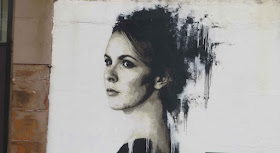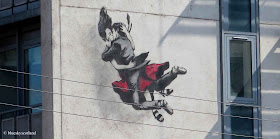ALL PHOTOS CLICK FULL SCREEN.
A recent solo walk in Glasgow City Centre saw me get off at Anderston Train Station, as usual, then head over the nearby pedestrian bridge to Glasgow's banking and financial district.
One of the reasons I like this approach so much is that on foot, from this direction, this western edge of Glasgow City Centre feels and looks like a very modern metropolis. Like the emerald city of Oz in fact. Brand new buildings springing up every couple of years to add to the ones already there.
It's also neat, quiet and tidy here.
On a bright sunny day this elevated pedestrian walkway into the heart of the financial district always makes me feel sunny and bright inside as well. Probably because I don't have to work there. I'm just a casual visitor. Yippee! New bank just completed with running track on the roof.
Just like the emerald city of Oz all that glass and steel requires maintenance. There they presumably have flying monkeys to polish all the buildings... as I know for a fact that the Wicked Witch Esmeralda hires them out on contract when they are not harassing Dorothy.
Here we have similar creatures, skilled at working in high places.
I thought the Moda Living Complex nearby would have been finished by now but they are still working on it, as you can see here...
Likewise the new building on Argyle Street, seen here, which is nearing completion.
I then popped down to the River Clyde Waterfront to see the other, (Kingston Street) side of the Barclays Bank Complex. Some of the buildings here are brand new...
Others are old buildings they have managed to save and repurpose. Note the red metal balcony at the rear of this property...
This is the back elevation of the same building. Although it is fairly colourful now it does look unfinished somehow to my eyes and for a few bucks more and a few cans of paint it could look eye-catching and outstanding... from even half a mile away.
My own idea for it.... to jazz it up a little. Just a thought.... Can you spot a dog and a hippopotamus?
They are still working on some of it... this may be a multi storey car park at a guess?
The front profile along the River Clyde Waterfront. They now have the flower borders in place.
Walkway/cycle-track along the front elevation of Barclays Bank Complex.
Decorative border display.
Although I was not really collecting murals I just happened to stumble across a few I hadn't captured before. This is by Mack Colours, the same guy(s) that put murals up in the abandoned
Shawbridge Arcade featured a few posts ago on here. Canary in a coal mine?
Both of these are found along the waterfront beside Clyde Street and the suspension bridge.
Virus mural?
Suspended Female.
Corvid not Covid. I say 'guys' as there's more than one name tag by the looks of itRailway Mural.
Glasgow Subway Mural. Nicknamed decades ago as 'The Clockwork Orange.'
All five murals found on Osborne Street near this pet shop and the Saltmarket. When I was a child I'm sure I bought my yellow budgie/ canary, my terrapin, tortoise, and hamster here.
Retro red bus.
Retro 1970s colours. I went to school in this type of bus and this particular colour scheme for many years. Number 48 and number 49 Nitshill or Priesthill. I could get either, the latter involved a 15 minute walk. Didn't think anything of it at the time but looking at it now it might only please one half of Glasgow :o)
St Andrews Parish Church. Built 1756.
Amazing to think this was built only ten years after the famous battle at Culloden 1n 1746 when the Highlands were finally crushed and subdued a year after Bonnie Prince Charlie landed in Scotland to kick-start the Jacobite Rebellion. 1756 was also the year when the Black Hole of Calcutta incident occurred. Poet Robert Burns was born a few years later in Ayrshire.
The adjacent St Andrew's Square. It's a beautiful restored development here but it always feels empty and desolate somehow... probably because you never see any residents coming and going or children playing outside. It usually looks like this. Very quiet.
Does have some lovely stone carving details though in this vicinity. Glasgow's coat of arms and motto.
The bird that never rang.. the tree that never flew... the bell that never swam.. the fish that never grew.... something like that anyway....
A study of a women in black mural....
A series of black and white portraits in this district by a well known street artist. This is just two of them.
Collegelands District.
Avenues and alleyways in Collegelands.
Collegelands and the University District.
Which brought me out at the Ingram Street murals of the four seasons. Autumn.
Summer. Photographed these murals around eight to ten years ago on the blog so I was very surprised how well the colours have held up. Hardly faded at all and still one of the real highlights of Glasgow's mural trail.
Winter.
Bee in meadow. A mural detail.
Indigenous peoples mural. Merchant city. Painted for the recent Cop 26 and climate change but could also stand for the original populations of North and South America during first contact with Europeans which within a few hundred years of exploration and exploitation managed to wipe out more than 130 million citizens or around 90 percent of the original inhabitants of each country there through disease, slavery, neglect, and torture than most of dead of the various European Wars we celebrate every year and remember to this day. It is what it is.
Same mural. A close up detail.
And across the street... high up on a nearby building... two passionate dancers are entwined.
And a cracking tasty meal when I got home. Broad beans, sausage, baby spuds with butter, salad cream, fried cherry tomatoes, fried onions, boiled egg. Yum yum.








































































